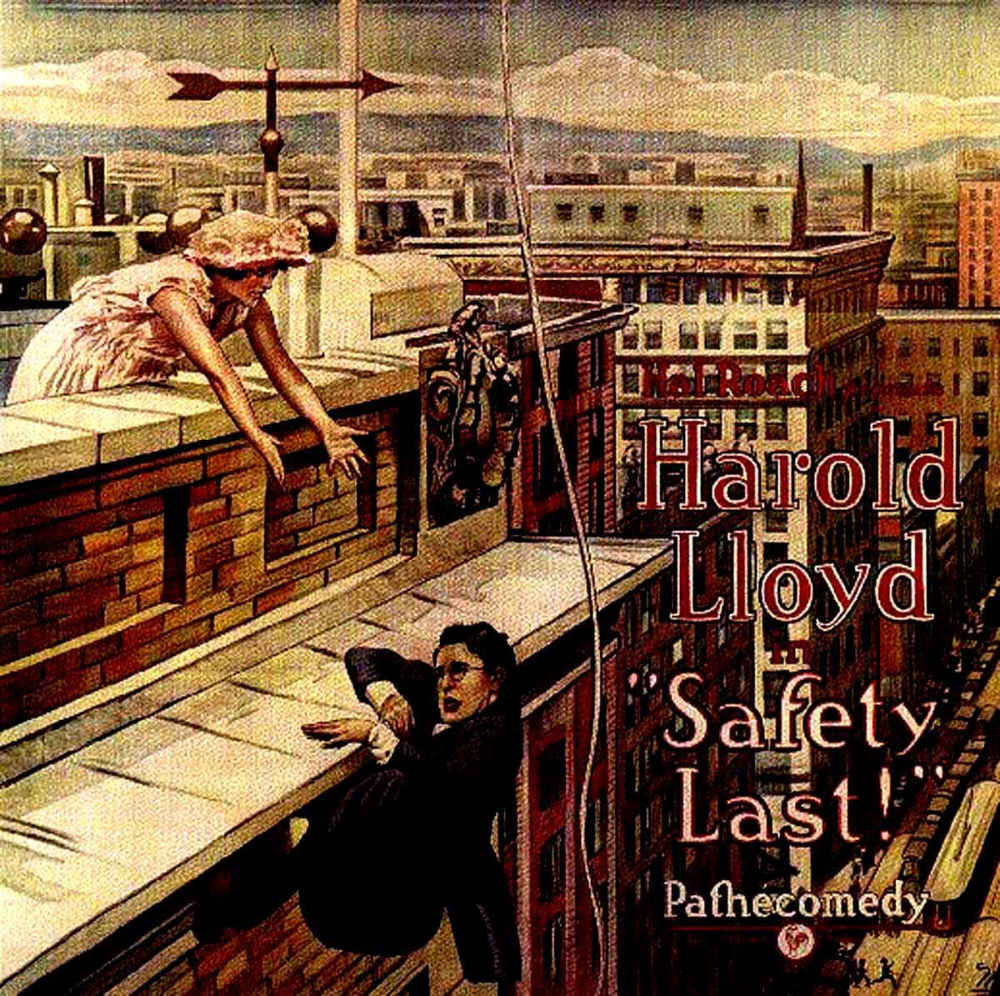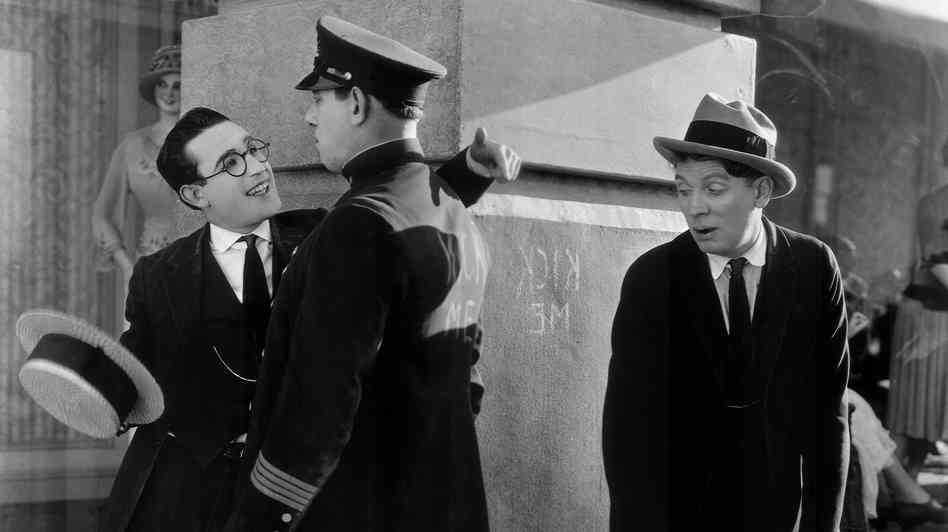Harold Lloyd’s Safety Last
Posted by keith1942 on January 27, 2014
The feature:
This film contains one of the most famous images in all of Hollywood silent comedy – as The Boy attempts a daredevil climb up the exterior of a twelve-story city Department Store. The stunts and the staging are impressive and justly iconic. However, the whole film features a longer and more complex story with a satisfying resolution for fans. The characters have almost mythic titles, the Boy, the Girl, and the Pal. Characters’ names [those of the actors] do appear in the title cards. Essentially the film divides into three parts.
The film opens in the stereotypical small town of ‘Great Bend’. Here we meet The Boy and his sweetheart. In a classic US formula he leaves to make his fortune in the big city. His early days there involve some comic incidents as Harold tries to make his way whilst at the same time re-assuring his sweetheart in letters home. The gags play with the hustle and bustle of the city (unnamed Los Angeles]. One sequence follows Harold as he rushes to work using first a tram then more unorthodox transport. A recurring situation involves small jewellers where Harold buys a present for his girl. There is a less than sensitive use of stereotypes here with the character of the clearly Jewish shop owner.
In the central section Harold is working in a Department Store. This is a regular setting in 1920s films. Clara Bow’s great hit It! (1927) features her in a similar situation: intriguingly the rather different Soviet classic New Babylon (1929) uses a similar setting to far different purpose. With its kaleidoscope of goods and customers the Department Store seemed to typify the exciting new world of the ‘20s’. There are some familiar generic gags here, including the authoritarian FloorWalker. And then a little later there is the chaos of the sales season. There is also another unfortunate stereotypical joke, this time with an Afro-American janitor. He is reduced to the eyeball-rolling stereotype of the period. Then Harold’s sweetheart comes to see him at his place of employment. There are some fine comic moments as Harold pretends to a higher status than he actually enjoys in the store.
It is Harold’s need to succeed and to please and impress his sweetheart that leads to the spectacular action of the last third of the film. Here the plot picks up on particular facets of the ‘20s’, ‘the human fly’. Just as the period was one of dizzying construction to ever-greater size and height, so humans with enough bravura made their mark on these new colossi. In fact, The Boy’s Pal is played by an actual ‘human fly’, whose stunts had impressed Lloyd. The film combines the thrills and spills expected in silent comedy with a series of great and developing gags. And through it all Lloyd’s Boy is driven on by his need to succeed. This comedy cleverly embodies a central tenet of the ‘American Dream’. It is likely that the combination of comedy and optimism accounted for it being one of the great comic successes of the 1920s.
Harold Lloyd
Lloyd was one of the three most successful and popular Hollywood comics of the silent era. “Harold Lloyd’s character, both on and off screen, typified optimism. Very much the embodiment of the concept of succeeding through confidence, hard work and determination. Lloyd was in a sense the most positive screen presence of the major silent comedians.” (A-Z of Silent Film Comedy, Glenn Mitchell, 1998). This would also seem to make Harold the most positive representative of the ‘American Dream’ in US silent comedy.
As with so many screen comics he started out in a stock repertory company. His first screen appearance was as an extra in an Edison Company film The Old Monk’s Tale (1913). He then worked first for Max Roach and afterwards Max Sennett. When Max Roach was able to start independent production Lloyd starred in a series of comedies as ‘Lonesome Luke’. Like many other would-be comic stars this was a variation on the character made famous by Charlie Chaplin. Roach produced about 100 short films in this series with great success.
Harold’s first role in the recognisable Lloyd character, with the familiar spectacles and straw boater, was the one-reel Over the Fence (1917). Hal Roach was instrumental in developing this new persona which moved away from the caricature associated with earlier comics and presented a recognisable young and ambitious hero. The new character was full of resourcefulness and determination, and also possessed a streak of ruthlessness. One aspect of Lloyd’s persona is a variation of the traditional character of ‘the trickster’. He is always coming up with unconventional and often illegitimate resolutions to problems. Examples of this recur throughout Safety Last.
One film, Look Out Below (1918) utilised the skyscraper as a setting: something with which Lloyd became famously associated. In another, Picture Show (1919) the stunts led to a hand injury and the loss of both a thumb and forefinger. Impressive and realistic-looking stunts were to be come a staple of the Lloyd’s film successes. As with other silent comics Lloyd was adept at stunt work and many of the spectacular feats in Safety Last involve him. There were, of course, safety precautions, usually just outside the line of the camera shot.
Lloyd was in the forefront of producing comic films of increasing length. Most silent comedies up until the early 1920s were one and two reel films. Projection speeds were gradually increasing in this period: originally a reel ran for fifteen minutes, by the early 1920s this had decreased to 12 minutes of less. In 1921 Harold Lloyd starred in Now Or Never, Among Those Present (1921) and Never Weaken, all three-reel films. This gave a running time approaching 40 minutes. A Sailor-Made Man ran for four reels. Whilst Grandma’’ Boy (1922) was five reels, reaching about an hour in running time. Both Charlie Chaplin and Buster Keaton were also moving on to feature length comedies, with developed narratives rather than the episodic plots that characterised early silent comedies. All three comics developed narrative construction and characterisation to support the increased viewing lengths.
All this time Lloyd was working for Hal Roach. Safety Last owes a lot to the input of Roach, one of the masters of the gag in silent film. In 1924 Lloyd set up the Harold Lloyd Corporation, though he retained the link with Pathé. His first feature was Girl Shy (1924). Later Lloyd moved to a distribution deal with Paramount, on eof the emerging Hollywood Majors. All through this period Lloyd enjoyed great popularity and success. His last silent comedy was Speedy (1928) set around an old horse-drawn tram service in New York.
Unlike a number of the silent stars Lloyd did manage the transition to sound comedy. He made five sound features, though with decreasing success and then retired form filmmaking. He received a Special Academy Award in 1952 as a ‘master comedian and good citizen’. In the 1960s compilations of his silent comedies revived his popularity and he received a standing ovation at the 1962 Cannes Film Festival.
The film:
Hal Roach Studios. Distributed by Pathé Exchange, 1923.
Director Fred Newmeyer and Sam Taylor. Story by Hal Roach, San Taylor and Tim Whelan. Cinematography Walter Lundin. Art Director Fred Guiol. Titling H. M. Walker. Black and White, 7 reels.
Cast: Harold Lloyd – The Boy. Mildred Davis – The Girl. Bill Strother – The Pal. Noah Young – The Law. Westcott B. Clarke – The Floorwalker. Mickey Daniels – The Kid. Anna Townsend – The Grandma.
The print:
The recent screening at the National Media Museum used a 35mm copy of the original film. The print has an added soundtrack, which was switched off. A colleague who saw and heard this print thought the music track was not very good. Fortunately the Museum screening enjoyed the services Darius Battiwalla, providing live accompaniment on the piano.
Sound prints run at 24 fps. One of the projection team checked and found that Safety Last was shot at 22 fps, so this was the projection speed used in the screening. It looked just right and the print was in good shape.


Safety Last, USA 1923 | Friends of Hyde Park Picture House said
[…] last time I saw a print it had an added soundtrack, but this can be switched off. Certainly when it originally […]
Hippodrome Festival of Silent Cinema 2016 « Early & Silent Film said
[…] film was written directed by Sam Taylor. One of his more famous films was Harold Lloyd’s Safety Last (1923). The film also enjoyed the talents of Cedric Gibbons on the set designs: a craft person whose […]